Duttong
Religion
A Multidimensional Analysis of Religious Extremism. Introduction Recently, we witnessed a surge in psychological research examining the role of religion in human life (e.g., Ysseldyk et al., 2010; Coyle and Lyons, 2011; Brambilla et al., 2016).

This rise in interest can probably be explained by recent concerns in the Western world about the social and political implications of the surge of “bad religion” (Basedau et al., 2016).
Programs and Projects – Indigenous Justice Clearinghouse. The Indigenous Justice Clearinghouse encourages the sharing of information about programs and projects that are having success to reduce Indigenous over-representation in the criminal justice system and keep communities safe.
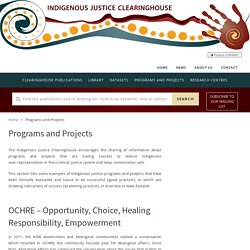
This section lists some examples of Indigenous justice programs and projects that have been formally evaluated and found to be successful (‘good practice’), or which are showing indications of success (‘promising practice’), in Australia or New Zealand. OCHRE – Opportunity, Choice, Healing Responsibility, Empowerment In 2011, the NSW Government and Aboriginal communities started a conversation which resulted in OCHRE, the community focused plan for Aboriginal affairs. Since then, Aboriginal Affairs has continued the conversation about the issues that matter to Aboriginal people – governance, strengthening language and culture and supporting young people to positively transition from school into further study, training or employment.
Australian Bureau of Statistics. From 30 June 2019 to 30 June 2020, total prisoners decreased by 5% (728) to 12,730.

The largest movements by offence/charge were: Unlawful entry with intent, down 18% (169)Illicit drug offences, down 6% (137)Sexual assault and related offences, up 6% (121). This was the second successive annual decrease and numerically the second largest decrease after Victoria. The imprisonment rate decreased by 8% from 214 to 197 prisoners per 100,000 adult population.
Department for Correctional Services - Contact the Aboriginal Services Unit. The Aboriginal Services Unit is based in DCS central office and also has presence in each of the prisons.
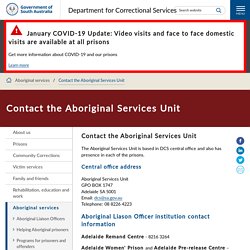
Central office address. Department for Correctional Services - Aboriginal Liaison Officers. Aboriginal Liaison Officers (ALO) contribute to the implementation of the recommendations from the Royal Commission into Aboriginal Deaths in Custody.

They work at designated prison and community corrections centres to provide assistance to Aboriginal prisoners and offenders. They also act as a point of contact and a resource for families of Aboriginal prisoners and offenders. Aboriginal Liaison Officers maintain close working relationships with many of our other staff, and the community groups and support agencies who promote the welfare of Aboriginal prisoners and offenders.
They can also provide advice, support and follow-up services.
Aboriginal mothers are incarcerated at alarming rates – and their mental and physical health suffers. Aboriginal women are the fastest growing prison population in Australia.
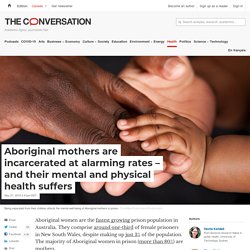
They comprise around one-third of female prisoners in New South Wales, despite making up just 3% of the population. The majority of Aboriginal women in prison (more than 80%) are mothers. Our research team interviewed 43 Aboriginal mothers in six prisons across NSW about their physical and mental health and well-being.
Indigenous affairs overview. Budget Review 2019–20 Index James Haughton Indigenous budget drivers Over the last decade, the Productivity Commission’s Indigenous Expenditure Reports (IER) have consistently shown that total Commonwealth, state and territory government per capita expenditure on Aboriginal and Torres Strait Islander people is approximately double the per capita expenditure on non-Indigenous Australians.
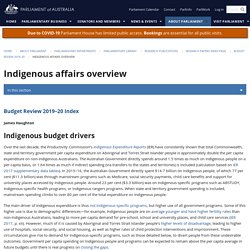
Imprisonment rates of Indigenous women a national shame. The Aboriginal and Torres Strait Islander Social Justice Commissioner June Oscar AO has described the imprisonment rates of Indigenous women as a national disgrace.
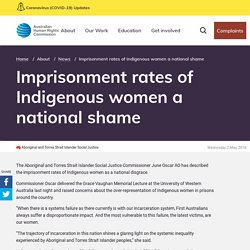
Commissioner Oscar delivered the Grace Vaughan Memorial Lecture at the University of Western Australia last night and raised concerns about the over-representation of Indigenous women in prisons around the country. “When there is a systems failure as there currently is with our incarceration system, First Australians always suffer a disproportionate impact.
Adult prisoners. Overrepresentation When comparing the 2018 prison population to the general adult population, prisoners were: far more likely to be male—more than 8 in 10 (85%) adult prisoners were male, compared with 49.6% of the general adult population (AIHW 2019) more likely to be Aboriginal and Torres Strait Islander Australians—almost 2 in 5 (38%) adult prison entrants were Indigenous, compared with just 3.2% of the adult population (see Indigenous community safety) younger—2 in 3 (66%) prisoners were under 40, compared with around 1 in 3 (32%) in the general community aged 18 to under 40 (ABS 2018a).
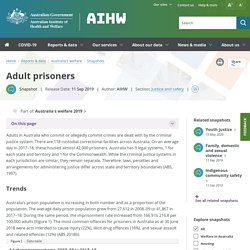
The Ethical Framework for Research Involving Prisoners - Ethical Considerations for Research Involving Prisoners - NCBI Bookshelf. Rose Jackson's Policy Safari: Episode Two - How do we fix NSW Prisons? on Apple Podcasts. Indigenous justice - Amnesty International Australia. Everything you need to know “We launched our Community is Everything campaign in 2015 because we don’t want to see Indigenous kids locked up anymore,” explains Amnesty International Indigenous Rights Advisor Rodney Dillon.

“We want to see them living in happy, healthy communities, finishing school, getting good jobs and becoming community leaders.” We know that putting kids in jail only makes matters worse. It should be a last resort but research by the Victorian government shows that Indigenous kids are much more likely to be charged by police, than cautioned and referred to a support program.
Community is Everything: Eugene’s story - Amnesty International. 5 January 2016 What are the solutions to keeping Indigenous kids in communities and out of detention? All over Australia – in urban, regional and remote communities – Indigenous leaders and community members know the way forward for their children.
Raise the Age Kids Belong in Community 2020.
Research publications. A Voice for Progressive Reform: An Interview With Labor MLC Rose Jackson. During her June maiden speech in NSW parliament, newly-incumbent Labor MLC Rose Jackson reminded those gathered that this state was once a world leader in harm reduction, which was exemplified by the establishment of the Uniting Medically Supervised Injecting Centre in Kings Cross.
And she went on to underscore that it’s time for the state to make its way back to the head of the pack and consider legalising cannabis, as has now been done in eleven US states, along with the entire nations of Canada and Uruguay. Another area where NSW is sadly falling behind is pill testing. Ms Jackson asserted that a trial of this harm reduction approach should take place over the 2019-20 summer festival season, with the obvious aim of saving lives, and the sometimes overlooked consequence of lowering drug use.
'Urgent action' needed over high proportion of Indigenous women in prison, report says. 4714.0 - National Aboriginal and Torres Strait Islander Social Survey, 2014-15. The extent of family and domestic violence experienced by Aboriginal and Torres Strait Islander women has been revealed in a new Australian Bureau of Statistics (ABS) report using previously unpublished data from the 2014-15 National Aboriginal and Torres Strait Islander Social Survey.
ABS Director of the Centre of Excellence for Aboriginal and Torres Strait Islander Statistics, Debbie Goodwin said “Of those women who had experienced violence, more than two-thirds (72 per cent) identified an intimate partner or family member as a perpetrator in their most recent experience. This was twice the rate reported by Aboriginal and Torres Strait Islander men (35 per cent). “About four in 10 (43 per cent) women who were physically injured visited a health professional for their injuries and six in 10 (60 per cent) reported the incident to police.” Document Selection These documents will be presented in a new window.
4714.0 - National Aboriginal and Torres Strait Islander Social Survey, 2014-15. Any reference to males, females or persons in this article refers to Aboriginal and Torres Strait Islander people aged 15 to 64 years unless otherwise specified. There is considerable interest in the social and economic circumstances of Aboriginal and Torres Strait Islander people who are not in the labour force.
A person is considered to be out of the labour force if they are: not employednot actively looking for work and not available to start work.
4714.0 - National Aboriginal and Torres Strait Islander Social Survey, 2014-15. Chapter 5. Introduction 5.1 Both the National Aboriginal and Torres Strait Islander Legal Services (NATSILS) and the Aboriginal Legal Service of Western Australia (ALSWA) stated that the reasons for the high imprisonment rates for Aboriginal and Torres Strait Islander persons are 'well documented'.[1] Further, ALSWA commented that the reasons 'have been repeatedly examined by numerous federal and state inquires'.[2] ALSWA, among others, summarised these factors as follows: [T]he reasons fall into two main categories.
The first category are underlying factors that contribute to higher rates of offending (eg, socio-economic disadvantage, impact of colonisation and dispossession, stolen generations, intergenerational trauma, substance abuse, homelessness and overcrowding, lack of education and physical and mental health issues).
4714.0 - National Aboriginal and Torres Strait Islander Social Survey, 2014-15. 4714.0 - National Aboriginal and Torres Strait Islander Social Survey, 2014-15. 4714.0 - National Aboriginal and Torres Strait Islander Social Survey, 2014-15. Social determinants of incarceration. National Indigenous Australians Agency. Young people are not overrepresented in the criminal justice system. Corrective Services, Australia, September Quarter 2020. Young Mob - Aboriginal Youth Program. National Indigenous Australians Agency. Mills Gale 2007 IJQSE finalauthoversion. 12+ ways to reduce Aboriginal incarceration rates. Adults are not overrepresented in the criminal justice system.
Language Barriers in the Criminal Justice System. Indigenous Deaths in Custody: Arrest, Imprisonment and Most Serious Offence. Bourdieu Pierre Passeron Jean Claude Reproduction in Education Society and Culture 1990. Education Statistics for Aboriginal and Torres Strait Islander Peoples, 2018-19 financial year. UQ students launch national deaths in custody database. Drivers of incarceration for Aboriginal and Torres Strait Islander women. Twalsh crimlj v42 pt3. Change the Record. Royal Commission into Aboriginal Deaths in Custody - Inquiry - Historical Abuse Inquiries Internationally. 4 indigenous in custody. Bb41. Discussion paper 84 compressed cover2. Pathways to Justice–Inquiry into the Incarceration Rate of Aboriginal and Torres Strait Islander Peoples (ALRC Report 133)
UniSA partners with Adelaide Women’s Prison to design parenting program - News and events - University of South Australia. Indigenous Legal Issues - Law Council of Australia.
Aboriginal literacy rates. Lm46. Chapter 2. Keep young people out of prison. 12+ ways to reduce Aboriginal incarceration rates. Arc monash children of prisoners report 2015. Social Capital: Its Origins and Applications in Modern Sociology. KWOOP Coalition Profile of women in prison in NSW. Part A. A snapshot. Final 9 March 2020. KWOOP – Keeping Women Out of Prison – Sydney Community Foundation. Magistrates Court of Victoria. Racial and Gender Justice for Aboriginal Women in Prison — Power to Persuade. Beyond Bars - Are Prisons cost-effective? - Justice Action.










